You are here
Back to topConverter Verification for Automotive Application
Due to advances in technology, now we can explore all corners of the world more efficiently, such as driving vehicles to high altitudes or extremely low temperatures area. Therefore, the verification for automotive electronics is more stringent than consumer electronics. For example, automotive electronics parts need to withstand more extreme temperatures. So, safety and reliability are the most critical part in automotive electronics application, therefore relevant norms came into being.
Figure 1 shows the introduction of the electronic regulations for vehicles. As the figure shows, there are different specifications to be compared at different stages. The part of the quality system should be in accordance with the specifications defined in ISO 16949.
ISO 26262 is a functional safety standard for road vehicles. It focuses on the verification of the system and does not to be applied to IC or discrete components. And ISO 16750 is suitable for sub system for automotive parts or equipment.
Both two standards are not to be applied to IC or discrete components, like electrical connectors, PCBs, gauges, displays, controls, etc.
AEC-Q is a stress test qualification for discrete components in the automotive industry, so AEC-Q is suitable for power converter reliability verification.
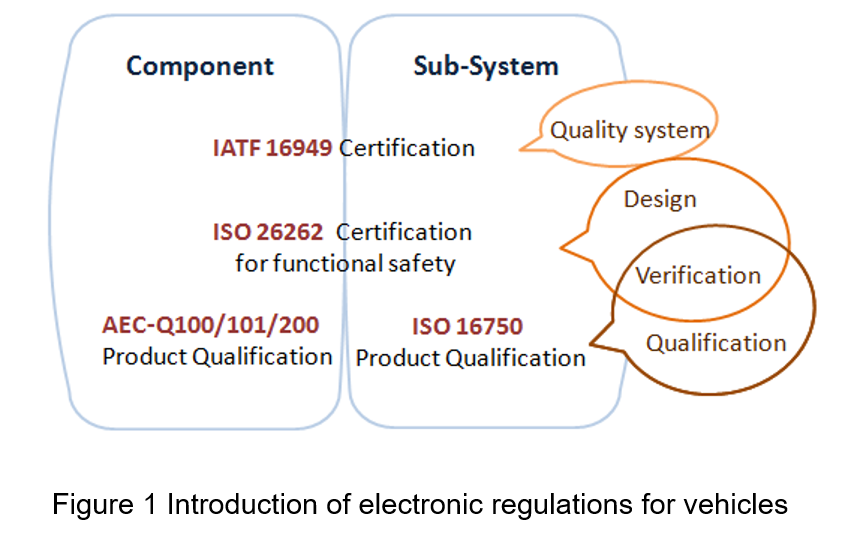
The definitions for automotive regulations are as follows
- IATF 16949 is the quality standard for the automotive industry. The standard applies to the design, development, production, installation and servicing of automotive-related products. Suitable for automobile manufacturers, production of automotive-related materials, automotive assembly parts, and so on.
- ISO 26262 is mostly adopted by European car manufacturers, focusing on risk assessment and constructing a comprehensive safety design process. Include functional safety management, safety lifecycle for automotive product design and development and automotive safety integrity levels.
- ISO 16750 specifies environmental reliability standards for automotive products that describe electrical loads, mechanical loads, climatic loads, and chemical load tests. Suitable for electronic equipment and large components that are directly mounted on vehicles.
- Automotive Electronics Council (AEC) regulates the quality and reliability of automotive electronics to prevent potential failure conditions. Mainly for the component parts of the automotive industry, including
AEC-Q100 (IC Chips)
AEC-Q101 (Discrete Components)
AEC-Q102 (Discrete Optoelectronic)
AEC-Q104 (Multichip Modules)
AEC-Q200 (Passive Components)
The AEC-Q200 includes capacitors, resistors, inductors, oscillators, transformers, fuses and so on. The location of each component is used in the engine area, passenger area, or non-vehicle area depending on the severity of the ambient temperature. There are five levels, as shown in Table 1.
| Grade | Temperature Range |
Passive Component Type Maximum capability unless otherwise specified and qualified |
Typical/Example Application | |
| Minimum | Maximum | |||
| 0 | -50°C | +150°C | Flat chip ceramic resistors, X8R ceramic capacitors | All automotive |
| 1 | -40°C | +125°C | Capacitor Networks, Resistors, Resonators, Crystals and Varistors, all other ceramic and tantalum capacitors | Most underhood |
| 2 | -40°C | +105°C | Aluminum Electrolytic capacitors | Passenger compartment hot spots |
| 3 | -40°C | +85°C | Film capacitors, Ferrites, P/R-C Networks and Trimmer capacitors | Most passenger compartment |
| 4 | 0°C | +70°C | Non-automotive | |
Test items for inductors and transformers are mentioned in Table 5 of the AEC-Q200, as shown in Table 2. In addition, the transformer is mentioned in Appendix 1, as shown in Table 3, definition of a qualification family. And it pointed out that the converter belongs to that series, so the table 5 is suitable for the verification standard of the converter.
| No. | Stress | Sample Size |
| 1 | External Visual | All qualification parts submitted for testing |
| 2 | Pre- and Post-Stress Electrical Test | All qualification parts sub,itted for testing |
| 3 | Electrical Characterization | 30 |
| 4 | Physical Dimension | 30 |
| 5 | High Temperature Exposure (Storage) | 77 |
| 6 | Temperature Cycling | 77 |
| 7 | High Temperature and High Humidity | 77 |
| 8 | Operational Life | 77 |
| 9 | Resistance to Soldering Heat | 30 |
| 10 | Solderability | 15 |
| 11 | Mechanical Shock | 30 |
| 12 | Vibration | 30 |
| 13 | Board Flex | 30 |
| 14 | Terminal Strength (SMD) | 30 |
| 15 | Terminal Strenghth (Leaded) | 30 |
| 16 | ESD | 15 |
| 17 | Flammability | Present certificate of compliance |
| 18 | Resistance to Solvents | 5 |
| 1 | Capacitor Technology | Aluminum Electrolytic |
| Tantalum | ||
| Ceramic | ||
| Film | ||
| Networks | ||
| Trimmers | ||
| 2 | Resistor Technology | Thin Film |
| Thick Film | ||
| Networks | ||
| Trimmers | ||
| Wirewounds | ||
| Molded Metal Strip | ||
| 3 | Inductors | Fixed (Axial/Radial/SMD) |
| Ferrite Cores | ||
| Wirewound | ||
| Multilayer | ||
| Variable | ||
| 4 | Transdoemers | Pulse Transformers |
| SMD (for dc to dc converter) | ||
| Switch Mode Power Transformers | ||
| SMD (for Pulse Applications) | ||
| 5 | Varistors | Ring Varistors (Barium-Titanium Oxide) |
| Disc Varistors (Zinc Oxide) | ||
| Muitilayer Surface Mounted Varistors | ||
| 6 | Thermistors | For Motor Starting |
| For Overcurrent Limiting | ||
| For Temperature Compensation | ||
| 7 | Crystals | Metal AT CUT |
| Metal AT STRIP | ||
| Molded Surface Mounted |
Application Profile
Every sample has to pass the basic test items, before conducted the verification items specified in AEC-Q200, like external visual, pre- and post-stress electrical test, electrical characterization and physical dimension. The electrical test must meet the specifications, and the appearance shall not be damaged. It is on depends, if there are some special regulations. Some of the verification items should measurement every 250 hours until the required 1000 hours.
According to AEC-Q200 table 5, the test items suitable for converter are shown as below.
1. High Temperature Exposure
This test is exposure samples in an elevated extreme ambient temperature, like 125℃, 105℃ or 85℃ for 1000 hours, while the samples are unpowered.
High temperature accelerates the heat aging of materials and may cause the case cracking and softening. The materials have different coefficients of thermal expansion. Therefore high temperature will cause deformation or damage of the product that is design defect or has poor manufacturing process.
2. Temperature Cycling
The temperature cycling test is to place the sample in a temperature-converted environment. As shown in figure 2, two extreme temperatures are -40 ° C and 125 ° C for 30 minutes each, and the two temperatures transition time must be less than one minute until the completion of 1000 cycles.
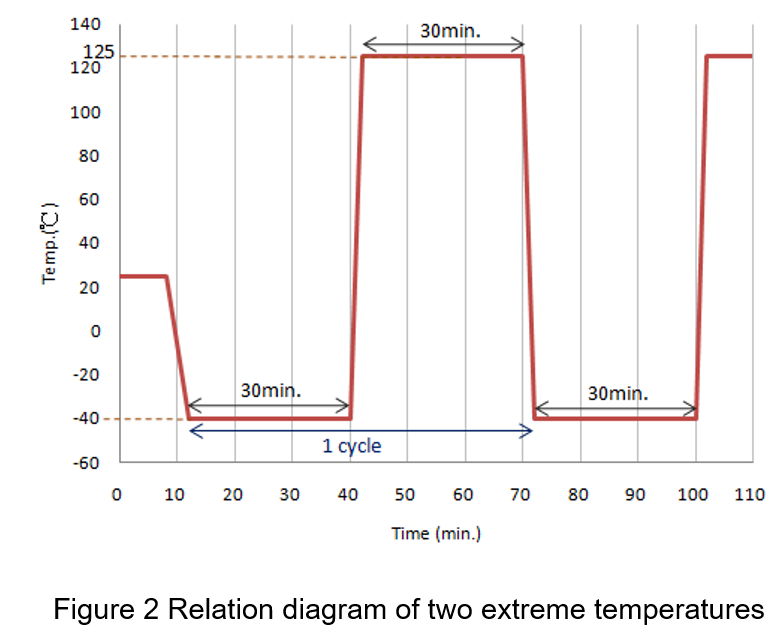
The most important effect of temperature change is the expansion and contraction of the material. Due to the different thermal expansion coefficients of different materials, the appearance or structural may be damaged and even the internal components may be affected if the bonding between materials is not good.
Accelerate products aging by rapid temperature change, and screen out potentially defective products to ensure the design and manufacture of the product is correct.
3. High Temperature and High Humidity
This test is the continuous exposure of the sample to 85% relative humidity at 85℃ for 1000 hours.
Temperature and humidity are the indispensable conditions for the natural environment. Therefore, the high temperature and high humidity test are used to evaluate whether the material of the product can withstand the resistance of moisture corrosion.
4. Operational Life
The sample is placed in a maximum operating temperature (125℃/105℃/85℃) for 1000 hours, while the sample is performing its operational function. This test simulates the actual use conditions and uses the temperature and voltage as the acceleration factors. According to the relation between the failure time and the stress infers the operational life of the product under normal conditions.
5. Resistance to Soldering Heat
Table 4 shows the test condition of resistance to soldering heat. Maintain the solder temperature to 260 ° C and last 10 seconds for immersion time. The sample shall be visually inspected under 10 times magnification after completion.
This test is performed to determine whether wire and other component parts can withstand the effects of the heat to which they will be subjected during the soldering process .The heat of soldering could cause solder reflow which may affect the electrical characteristics of the component part and may cause mechanical damage to the materials constitute the part.
| Test Condition | Solder Temperature (°C) | Time(s) | Temperature ramp /immersion and emersion rate | Number of heat cycles |
| B | 260±5 | 10±1 | 26mm/s ± 6mm/s | 1 |
6. Solderability
To evaluate the ability of the product to be soldered on the substrate during assembly has no adverse effect. Table 5 shows the test condition, there are leaded and SMD types, which be defined respectively different steam conditions and solder temperatures as shown in Table 6. Electrical Test is not required, but all leads shall exhibit a continuous solder coating free from defects for a minimum of 95% of the critical area of any individual lead.
| J-STD-002C Method | Steam category | Solder Temp. | |
| Leaded | Method A | category 3 | 235°C |
| SMD | a) Method B | 4hrs @ 155°C dry heat | 235°C |
| b) Method B | category 3 | 215°C | |
| c) Method D | category 3 | 260°C |
| Category 1 | Category 2 | Category 3 |
| No Steam Conditioning Requirements | 1 Hour ± 5 min. Steam Conditioning | 8 hours ± 15 min Steam Conditioning |
7. Mechanical Shock
This test is conducted for the purpose of determining the suitability of component parts and subassemblies of products and electronic components when subjected to shocks such as those which may be expected as a result of rough handling, transportation and military operations. And according to the result of the test, the structural weaknesses can be analyzed and improved.
The mechanical shock simulates the actual environment shock by an instantaneous half-sine shock pulse with an acceleration of 100g's, the condition as shown in Table 7. Three shocks in each direction shall be applied along the three mutually perpendicular axes of the test sample (18 shocks).
| Test Condition | Peak Value (g's) | Normal duration (ms) | Waveform | Velocity change (ft/sec) |
| C | 100 | 6 | Half-sine | 12.3 |
8. Vibration
The entire frequency range of 10 to 2,000 Hz shall be traversed in 20 minutes. This cycle shall be performed 12 times in each of three mutually perpendicular directions (total of 36 times), so that the motion shall be applied for a total period of approximately 12 hours.
Products that are in transit or in a vibrating environment may be considered to be subject to repeated stresses due to similar vibration frequencies. Repeated stress can cause fatigue which may cause the solder ball to break. Therefore, this test could screen out defective products that have unstable fixed methods and structural designs.
9. Board Flex (SMD)
This test is conducted to determine the ability of surface mounted device terminations and sealed to withstand bending, flexing and pulling forces which occur on printed circuit boards during handling and assembly. Sample mounted on a specified PCB and used the specified reflow conditions. Place the board as shown in Figure 3 with the component facing down. The apparatus apply a force which will bend the board (D) ≧ 2 mm. The duration of the applied forces shall be 60 seconds. The force is applied only once to the board.
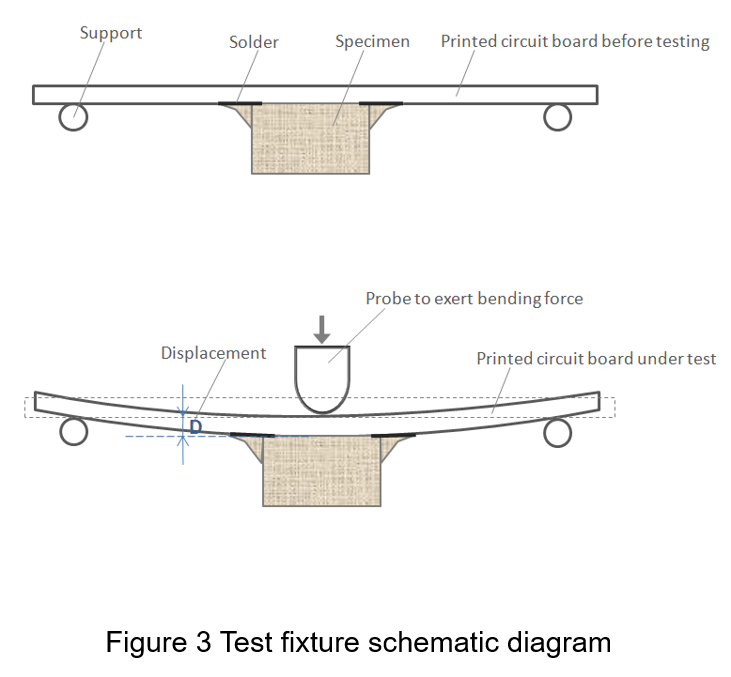
10. Terminal Strength (SMD)
The purpose of this test is to verify that the component terminations can withstand axial stresses that are likely to be applied during normal manufacturing and handling of a finished printed circuit board (PCB) assembly.
Figure 4 shows test method. The sample mounted on a PCB with the device to be tested and applied a 17.7 N (1.8 Kg) force to the side of the sample. This force shall be applied for 60 seconds. Magnification of 20 times or greater may be employed for inspection of the mechanical integrity of the device body, terminals and body/terminal junction. Before, during and after the test, the sample shall comply with all electrical requirements.
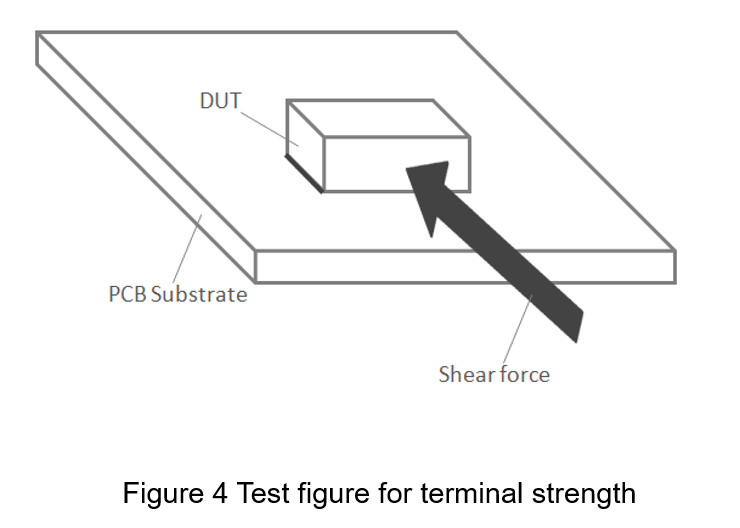
11. Terminal Strength (Leaded)
This test is performed to determine whether the design of the terminals and their method of attachment can withstand one or more of the applicable mechanical stresses. They will be subjected during installation or disassembly in equipment.
Pull test is usually applicable to non-bendable terminals. The point of application of the force and the force applied shall be in the direction of the axes of the terminations and last for 5~10 seconds, as shown in figure 5.
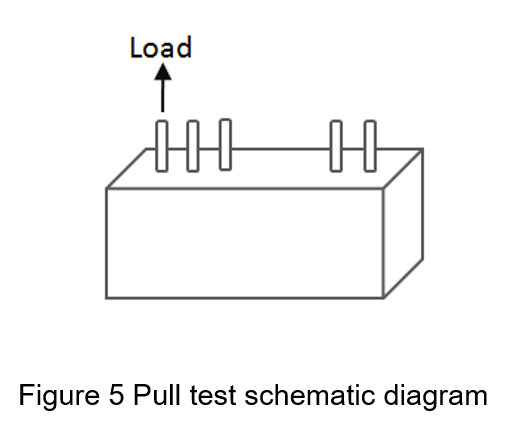
12. Terminal Strength (Leaded)
This test is performed to determine whether the design of the terminals and their method of attachment can withstand one or more of the applicable mechanical stresses. They will be subjected during installation or disassembly in equipment.
Pull test is usually applicable to non-bendable terminals. The point of application of the force and the force applied shall be in the direction of the axes of the terminations and last for 5~10 seconds, as shown in figure 5.
| Component Classfication | Maximum Withstand Voltage |
| 1A | <500 V (DC) |
| 1B | 500 V (DC) to <1000 V (DC) |
| 1C | 1000 V (DC) to <2000 V (DC) |
| 2 | 2000 V (DC) to <4000 V (DC) |
| 3 | 4000 V (DC) to <6000 V (DC) |
| 4 | 6000 V (DC) to <8000 V (DC) |
| 5A | 8000 V (DC) to <12,000 V (AD) |
| 5B | 12,000 V (AD) to <16,000 V (AD) |
| 5C | 16,000 V (AD) to <25,000 V (AD) |
| 6 | ≥25,000 V (AD) |
Figure 6 shows the test flow. It is permitted to use the same sample group for the next stress level if all samples in the sample group meet the acceptance criteria requirements specified.
Prior to ESD testing, electrical testing shall be performed on all samples in applicable user specification.
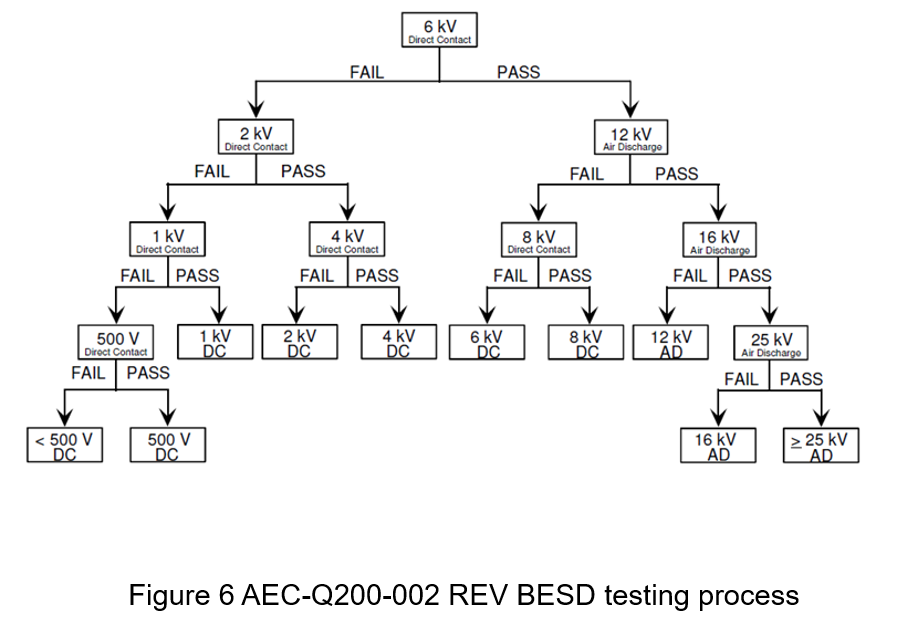
Summary
In the automotive industry application, the reliability of component is the customer care most. Due to automotive application is concerning to life safety, the reliability requirement is stricter than general industrial. Currently, there is no specialized verification for dc to dc converter module in the international regulations. But the reliability verification items can be summarized from the AEC-Q200, which are suitable for converter module. All test items meant to provide better quality and reliability for converter.
CTC is a professional service provider for high-end power supply modules (AC to DC Converter and DC to DC Converter) for critical applications worldwide since 30 years. Our core competence is to design and deliver products with leading technologies, competitive pricing, extremely flexible lead-time, global technical service and high-quality manufacturing (Made In Taiwan).
CTC is the only corporation certificated with ISO-9001, IATF-16949, ISO22613(IRIS), and ESD/ANSI-2020. We can 100% ensure not only the product, but also our workflow and service to match quality management system for every high-end application from the very beginning. From design to manufacturing and technical support, every single detail is operated under highest standard.

